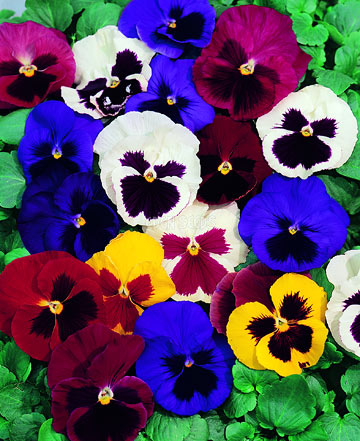Articles
Colour My World with Pansies
By Penny Ossowski
Pansies, with those interesting faces, watching you so seriously from the garden bed, (maybe saying ‘pick me I’d love to come inside’) as you pass by. The pansy is a cross of a couple of viola species, early varieties of which were wildflowers throughout many parts of Europe, the viola family includes both pansies and violets. William Thompson, gardener on the estate of Lord Gambier at Iver, Buckinghamshire in 1823 began crossing various species of viola that were the start of the modern Viola X wittrockiana or pansy. The name pansy is derived from the French word pensée meaning ‘thought’ because the flower resembles a face deep in thought. The pansy is a symbol for ‘Free thought’.
While initially biennials, modern crosses have been bred to be annuals. Through the years breeders have given us a wide range of colours to choose from including yellow, gold, orange, purple, violet, red, white and almost black. They fall into three main colour groups, a single colour such as yellow or blue, a single colour with black lines radiating out from the centre or the most common with the dark centre or ‘face’. A pansy flower has 2 top petals which overlap slightly, 2 side petals and a single bottom petal.

Some pansies selections, usually the yellow or blue ones, have a delicate perfume which is noticeable in the early morning, this was stronger in the original varieties.
In cold climates the pansy grows in the warmer months but in our warmer climate they grow best in our cooler months and will go on blooming as the warm weather starts but as it heats up will soon stop blooming and die. They do not like hot and muggy weather. Pansies can be grown in the garden or in pots. Pots can be moved into the house for short periods but prefer the outdoors. They do best in a rich, well drained soil with a ph between 6.0 and 6.5. They grow and flower best in full sun, but will tolerate partial shade but too much shade will cause them to get straggly and not flower. Plants will grow to about 20cm in diameter and about 15 to 20cm high. Seeds can be planted directly into the soil or in seed trays but they are small seeds so don’t plant too deeply and water in well (They take a while to germinate). When they start flowering pick flowers with their stem to go in vases or float bowls or if you prefer to leave them in the garden remove the spent flowers to encourage more flowers. Foliar fertilising will help them to bloom and stay healthier for longer.
They don’t have too many problems when growing. Slugs and snails do like their succulent leaves as do grasshoppers and occasionally aphids may attack them. Snails and slugs can be stopped with barriers or traps and the aphids can be treated with a ‘soap spray’. Pansies don’t like to be thirsty but try to water their roots not leaves. Mulch them well to conserve moisture.
Like their cousins the violets, pansy flowers are edible as are their leaves. They are high in Vitamin A and C. Flowers can be candied, used to make syrups, added to salads, as flavouring for honey or as garnishes. The flowers have a mild minty flavour.
Medicinally pansies have been used to make infusions and teas for treating skin conditions such as eczema and acne and for some urinary tract problems.
Pansies have inspired many artists and crafty people in pictures, postcards, embroidery, handiwork and ceramics. They have also inspired many writers and poets including Wordsworth, Shakespeare and D. H. Lawrence.
The Swiss Giant mix is very popular and available to buy seed online from Eden Seeds.
Add Pansies to your garden this year.



